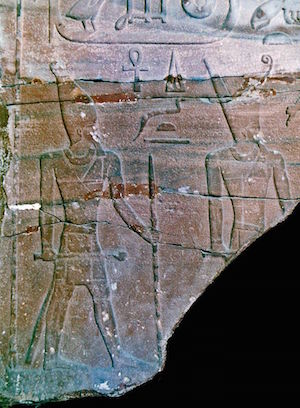
Sahure (“He who is close to Re”) ruled during the fifth dynasty (Old Kingdom) of Ancient Egypt. He seems to have had a peaceful and prosperous reign. Trade flourished and the Pharaoh opened up turquoise mines in the Sinai and diorite quarries in Nubia. Sahure is also credited with the creation of the Egyptian Navy. Unfortunately, his pyramid shows the marked decline in building standards which became common for the Kings of the Fifth Dynasty of Ancient Egypt.
Although it is generally agreed that his father was Userkaf there was disagreement regarding the identity of his mother. It was originally held that he was the son of Khenkaus I (who may be the lady known as Reddjedet in the story of Khufu and the Magicians, recorded in the Westcar Papyrus), however, excavations conducted on the causeway of his pyramid complex at Abusir suggest that his mother was actually Queen Neferhetepes.

His wife was Queen Neferetneby and he had at least two children, Ranefer and Netjerirenre. He was succeeded by Neferirkare who may have been his brother. A secondary inscription in the mortuary temple of Sahure’s pyramid complex records Neferirkare’s name and royal titles and some have proposed that he usurped the throne from the son of Sahure. However, it is also proposed by some that Neferirkare was the throne name of Prince Ranefer and that Prince Netjerirenre may have been one and the same as the pharaoh Shepseskare.
Although Userkaf built a Sun Temple at Abusir, Sahure was the first pharaoh to build his pyramid in the complex. The pyramid has been reduced to a pile of rubble, but the mortuary temple still has a discernible shape and many reliefs are now preserved in museums. There are many scenes depicting trading missions abroad.
One memorable scene shows Egyptian ships returning from Byblos in Lebanon bearing precious cedar trees. Another shows the king tending to a myrrh tree. The temple also records the first known expedition to the land of Punt, rich with myrrh, malachite, and electrum.

There are scenes of a raid into Libya (for livestock) and a scene showing the king smiting the local chieftains. However, their similarity with scenes in the mortuary temple of Pepi II and the Kawa Temple of Taharqa have prompted some to suggest that, like Pepi II and Taharqa, he did not in fact undertake a military expedition to Libya but was copying the achievement of an earlier pharaoh.
Sahure built a sun temple, named “Sekhet-re” (“the Field of Re”) but its location is unknown. His palace, modestly named “Uetjesneferusahure” (“Sahure’s splendor soars up to heaven”), is referred to on an inscription on debris in the mortuary temple of Neferefre’s pyramid complex, and so it may also have been located at Abusir.
According to the Turin Kings List he ruled for around twelve years but the Palermo Stone (which is contemporaneous) suggests that he may have reigned for thirteen years.
Pharaoh’s Names
Manetho; Sephres

Nebty: Nebkhau

Golden Horus: biku nebu (The two golden falcons)

Nomen and prenomen: Sahure (Abydos Kings list)
Bibliography
- Bard, Kathryn (2008) An introduction to the Archaeology of Ancient Egypt
- Dodson, A and Hilton, D. (2004) The Complete Royal Families of Ancient Egypt
- Kemp, Barry J (1991) Ancient Egypt: Anatomy of a Civilisation
- Malek, J (2000) “The Old Kingdom”, in The Oxford History of Ancient Egypt Ed I. Shaw
- Rice, Michael (1999) Who’s Who in Ancient Egypt
- Van De Mieroop, Marc (1999) A History of Ancient Egypt
Copyright J Hill 2016